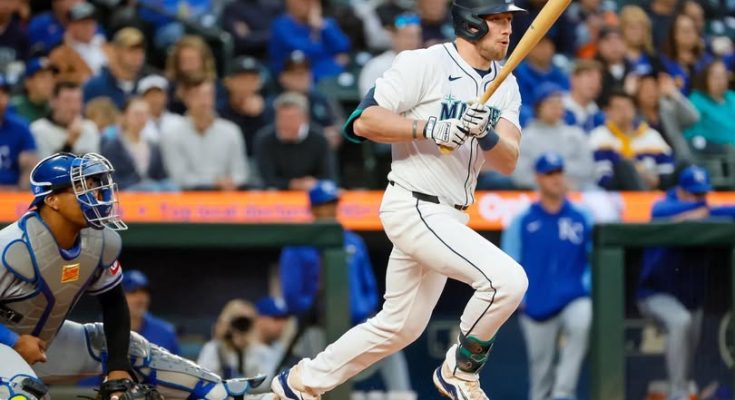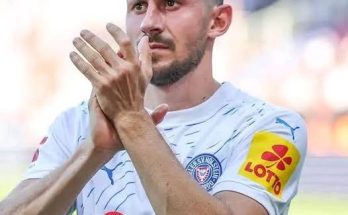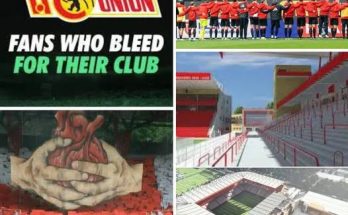The writing appears to be on the wall for Luke Raley in Seattle. Despite opening the season with a level of intrigue surrounding his positional versatility and left-handed bat, the current situation makes it nearly impossible to envision him maintaining a role on this Mariners roster much longer. Over the past several weeks, the signs have gradually become more and more obvious. The four-game series in Anaheim delivered perhaps the most glaring signal yet: Raley didn’t register a single at-bat. Not one appearance, not even a pinch-hitting opportunity. In the midst of that, his 1-for-10 slump with eight strikeouts only compounded the concern. It wasn’t just that Raley wasn’t producing—he wasn’t even being given a chance to contribute. That kind of omission is never arbitrary. It’s often the front office and coaching staff’s way of telegraphing what’s about to happen next.
When the Mariners acquired Josh Naylor—who has taken over first base duties with confidence and power—it essentially rendered Raley’s primary utility redundant. Raley had been valued for his ability to provide flexible depth across first base and the corner outfield positions, but versatility alone doesn’t keep you on a roster if it’s not accompanied by competitive production. And that’s precisely where Raley has failed to deliver. His current slash line of .220/.343/.348 is underwhelming, to say the least. While his on-base percentage remains respectable, it’s not enough to offset his lack of power or consistency at the plate. His .691 OPS reflects a bat that doesn’t bring enough threat or productivity to justify his continued place on a team looking to make serious postseason noise.
Meanwhile, Dom Canzone has been putting together an incredibly persuasive argument to be the everyday man in Raley’s place. With a batting line of .286/.320/.496 and an .816 OPS, Canzone has proven himself to be more than just a replacement-level contributor—he’s offering genuine impact. His offensive surge in recent weeks has come at exactly the right time for Seattle, offering a spark that the lineup has desperately needed. More importantly, Canzone’s production adds pressure to the Mariners’ front office to keep him in the everyday mix. Baseball is, at the end of the day, a results-oriented business. When a player is hot, you ride that wave. When another is cold and out of sync, you make room. In this case, that room appears increasingly likely to be created by cutting ties with Raley.
The timing here is also crucial. The MLB trade deadline is fast approaching, with just days remaining before front offices must finalize their rosters for the stretch run. This is the time of year when contending teams sharpen their focus, evaluate depth, and make difficult decisions. In that context, Raley becomes even more expendable. The Mariners are clearly buyers at the deadline, evidenced by the Naylor acquisition. And unless Seattle suddenly shifts toward a selling stance or includes Canzone in a surprise blockbuster trade—which seems unlikely given his current value to the team—there’s just no reasonable path for Raley to stick around. A lot would have to go wrong, or change dramatically, for him to survive past August 1st on this roster.
This isn’t necessarily an indictment of Raley’s overall career or future potential. Baseball is filled with players who hit a cold stretch, get released, and then find new life with another organization. But in this moment, with the stakes rising in Seattle and expectations climbing by the day, his struggles are simply too costly. He’s become a non-factor in the daily lineup, and that’s not something a playoff-contending team can afford to carry. Whether he’s designated for assignment, traded as a minor piece in a larger deal, or simply outrighted off the 40-man roster, the consensus inside the organization appears to be drifting toward a clear conclusion: Raley’s time is up.
It also bears mentioning how much the Mariners value defensive versatility and situational hitting in their depth pieces. Even within that framework, Raley isn’t stacking up well. While he’s capable of playing both corner outfield positions and filling in at first base, his defensive metrics haven’t provided enough boost to compensate for the underwhelming offensive numbers. Canzone, on the other hand, not only hits with more pop but has shown solid instincts in the outfield. And with Naylor now locked into first base, there’s even less need for Raley’s backup role. In essence, his flexibility has been neutralized by the efficiency and performance of other players on the roster.
The philosophical shift within the Mariners’ organization has also made things more difficult for fringe contributors like Raley. Seattle is no longer in a phase of experimentation or development. They’ve officially entered win-now mode. The team’s recent moves, clubhouse tone, and public statements by team executives reflect a franchise that expects to contend for the postseason and beyond. That transition inevitably means cutting emotional ties or marginal value assets to make room for players who can help win immediately. It’s a cruel aspect of the sport, but one that becomes unavoidable when ambitions escalate.
Raley’s presence on the team felt more viable earlier in the season when the Mariners were still searching for offensive rhythm and juggling lineup combinations. But the picture has since clarified. Players like Naylor and Canzone have helped stabilize key roles, and any additional moves at the deadline are likely to further crowd the roster. Whether it’s an upgrade to the outfield, infield depth, or bullpen support, the arrival of new talent will almost certainly force Seattle to trim the fat. Raley, unfortunately, seems to be the odd man out in nearly every possible scenario.
It’s also important to note how quickly these changes can unfold in Major League Baseball. One day a player is platooning, the next he’s out of the lineup, and by week’s end, he could be wearing a different uniform. The Mariners are making decisions with the postseason in mind, and they can’t afford to be sentimental. Every plate appearance counts. Every roster spot is a commodity. The team is fighting for positioning in a tightly contested AL playoff race. When you’re watching teams like the Yankees, Guardians, Astros, and Twins jockeying for similar spots, the margin for error is razor-thin. You don’t get to carry passengers when the train’s moving this fast.
From a financial standpoint, Raley doesn’t command a significant salary, which makes him easier to part with than a higher-priced veteran. That also makes him potentially more appealing to a rebuilding team looking for cheap, controllable depth. A low-risk, change-of-scenery flyer isn’t uncommon around the trade deadline, and Raley’s prior flashes of power could intrigue a club willing to give him a fresh look. But as far as the Mariners are concerned, their trajectory has shifted, and Raley simply doesn’t align with that upward arc anymore. The longer he remains on the roster without contributing, the more questions are raised about the team’s commitment to maximizing its potential.
The psychological element can’t be ignored either. When a player falls into a prolonged slump and loses playing time, it often becomes a mental hurdle as well. Confidence drops, mechanics falter, and the pressure to perform with limited opportunities only increases. Raley appears to be in that exact cycle. His strikeout rate has ballooned, his contact quality has dipped, and he looks like a player trying too hard to force results instead of finding rhythm. It’s unfortunate, but in the modern MLB environment, that’s often a death knell. There’s just not enough time to wait it out when there are healthier, hotter bats waiting in the wings.
Given all these factors, it would be nothing short of shocking if Luke Raley is still on the Mariners’ roster after the trade deadline. The writing is not only on the wall—it’s been underlined in red ink. Whether it’s a DFA, a quiet waiver wire departure, or a last-minute inclusion in a minor trade deal, the ending seems inevitable. Seattle has too much momentum, too much talent rising, and too many postseason aspirations to justify hanging on. Sometimes, the harshest part of a playoff push is the reality that not everyone can come along for the ride. For Luke Raley, that moment appears to be now.



